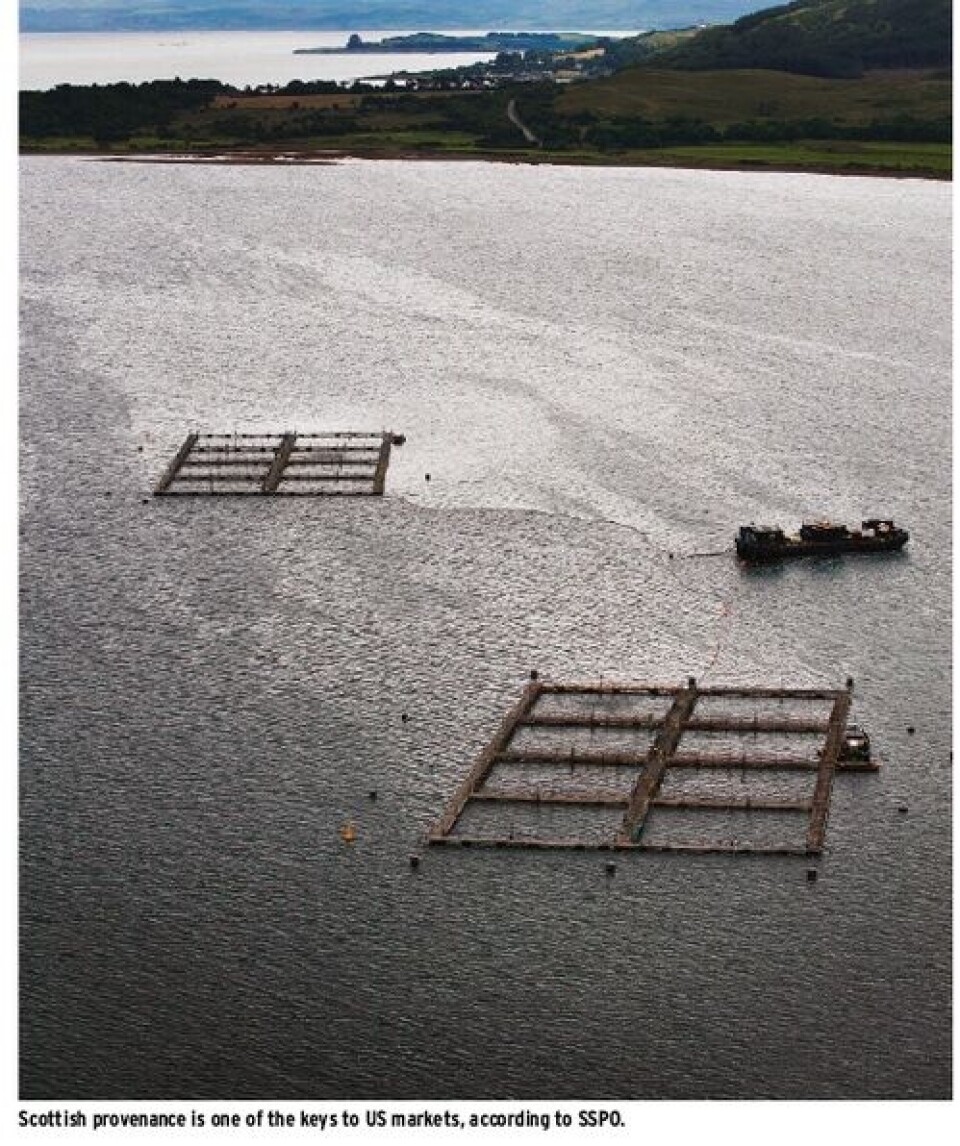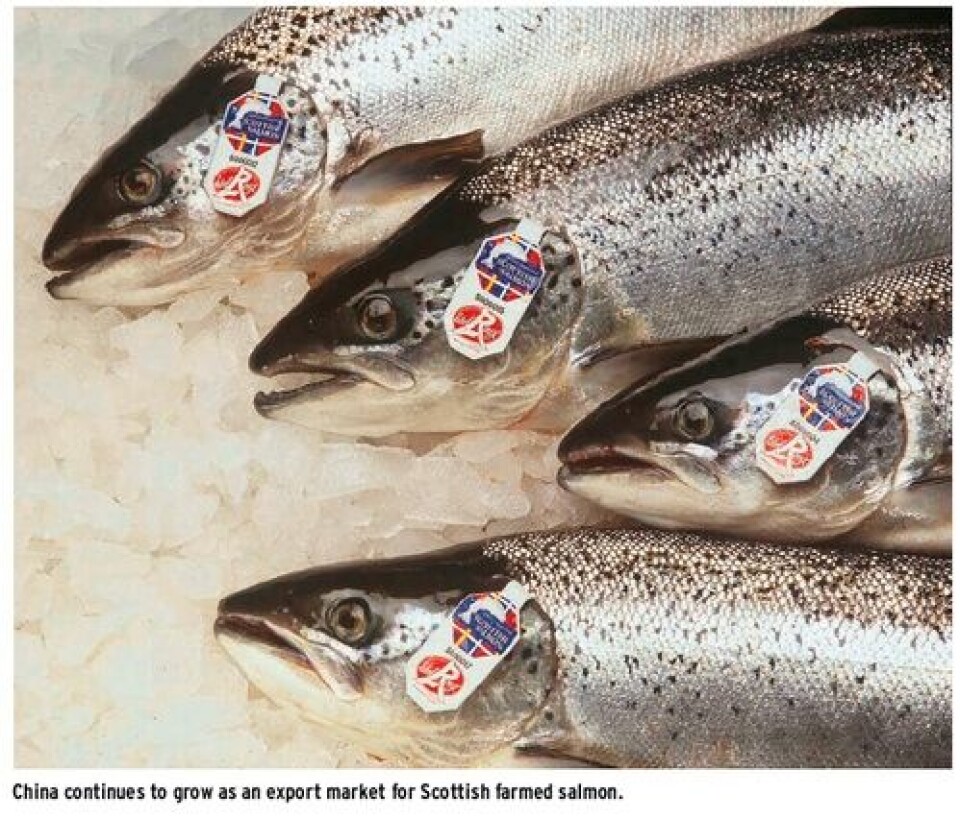Salmon playing a driving role in Scottish exports
By Siri Elisa Dybdal siri@fishfarmingxpert.com
The 2013 trade summary from Seafish, sourced from BTS, H & M Revenue & Customs and Globefish, revealed a mixed performance in export of seafood in 2013. However, salmon stood out as the number one export feature with strong value and volume growth.

After a dip in export to the US in 2012, volumes and value increased significantly in 2013 and Scottish farmed salmon sales to the USA hit nearly £200 million for the first time.
New and emerging markets such as China have also continued to grow. Between 2007 and 2012, exports of Scottish seafood to Asia increased by 247% and, trade with Vietnam, Taiwan, China and Hong Kong increased substantially in 2013.
UK’s biggest export species Salmon remains the UK’s biggest export species and has seen 9 per cent growth in export volumes. The positive price performance drove a 26 per cent growth in sales value.
The USA is the major export destination, importing almost entirely chilled headed fish. This is the fourth successive year that the USA has been the leading destination for Scottish salmon.
Exports of Scottish salmon to the USA are set to hit £200 million (£198,515,828) for the first time this year, according to figures from the Scottish Salmon Producers Organisation. The figures released reveal that in 2013, the farmed salmon sector saw its sales value to the USA rise from £155 million in 2012 to nearly £200 million in 2013, an increase of almost 30%. Volumes increased from 31,039,820 tonnes in 2012 to 38,488,192 tonnes in 2013.
The Seafish trade summary also showed that the average price per kg had increased slightly to £6.20 which is a 3 per cent rise.
According to the SSPO, the USA’s affiliation with Scotland, as well as quality and provenance are some of the selling points for Scottish farmed salmon. The firm texture of Scottish salmon is also suitable for use in Asian style cuisine, which continues to grow in popularity stateside. The majority of the shipments go to the East Coast. Large cities such as New York and Boston are key markets, but some Scottish salmon also reaches cities on the West Coast such as LA and San Francisco
“These impressive figures are the result of the fantastic reputation our salmon enjoys in the USA. Quality and Scottish provenance are key to the American market. Major retail chains and high end restaurants are delighted with the salmon we supply from Scotland. The industry has been supported by Scottish Development International (SDI) to open more market opportunities for Scottish salmon, making the USA our largest export market,” says Scott Landsburgh, chief executive of SSPO
Anne MacColl, chief executive of Scottish Development International, the international arm of Scotland’s enterprise agencies, also agrees that quality is a selling point in the markets the industry targets: “The US market recognises top quality in fresh food. This segment of the market demands the highest standards, and as Scotland is renowned for premium, health enhancing products, the US is an excellent place for our salmon companies to expand their International reach,” she claims.
“This is a great jump in our performance, but it should just be the start as we plan to invest in long term sustainable production to supply the demand for salmon and this will mean more jobs on the farms and in the food processing industry of Scotland. We look forward to a strong, sustainable future,” Jim Gallagher, managing director of Scottish Sea Farms, commented
According to Marine Harvest Scotland, volumes to the US had been lower in 2012 due to biological issues, but this had been rectified in 2013: “The difficulties with AGD in 2012 affected volume to the USA but the situation improved greatly in 2013,” says business support manager Steve Bracken
Drop in volume to France According to the Seafish figures, salmon to France is still the UK’s second largest seafood export however, whilst the value in pounds has increased 22 per cent to £107,889,000 in 2013, volume has dropped -7 per cent to 21,011tonnes. The average £/kg has increased 31 per cent to £6.13.
Martin Jaffa, consultant at Callender McDowell, who has been following the French salmon market closely for years, says he is not surprised by the results: “When salmon prices go up, the amount will decline. Salmon is now becoming too expensive. In France the market is not driven by discounts and offers in the same way as in the UK,” he points out. There is however currently a lot of cheap cod on the market in France and the French are buying into it and swapping salmon for cod, Jaffa says.
He believes the industry is ignoring the consequences of the high prices and questions the lack of innovation. “But the industry should be investing in the future and encourage salmon consumption through for example new products. This is not happening today. When the Saucy Fish Company came on the market it was something new. The supermarkets copied it as they don’t want to miss out. The farmers are not investing in growth. Currently they are all making money. But the high prices will eventually stifle further growth,” he claims and adds that the outlook for the overall consumption is bleak. He points out that the high prices could lead to another crisis down the road. “People forget,” Jaffa says and adds that it would be better if the companies could find a reasonable margin they could be happy with and work on producing salmon efficiently within these boundaries.

Growth in Asia China continues to grow as an export market for Scottish farmed salmon and last year and is the third most important export market for UK producers. Exports in 2013 came to 9710 tonnes, which is 48 per cent higher than in 2012, at a value of £60,429,000 – an increase of 33 per cent. The average price was £6.18 according to the figures released by Seafish, which is 24 per cent higher than the year before.
Marine Harvest Scotland is one of the companies that have been sending Scottish salmon to China. According to Bracken, Asia is a priority area for the company: “China and Asia remain the key new developing markets for our Scottish salmon. The bulk of our sales go direct to wholesalers and then retailers and processors.”
The Scottish government have worked purposefully towards the Chinese market in the last few years. In November last year First Minister Alex Salmond led a trade mission to China and undertaook a series of business and government meetings with the aim of taking Scottish firms to the heart of the world’s second largest economy and deepen the friendship between Scotland and China.
“China is an economic powerhouse with the second largest economy in the world and it is crucial that Scotland strengthens its position as an attractive place for Chinese investors and an exporter of high quality goods for that market,” said Alex Salmond.
There is also a new export plan targeting certain markets including China and several other Asian countries. The new Scotland Food & Drink Export Plan, developed jointly by the industry and government, aims to capitalise on the industry’s already tremendous success by focusing on 15 key export markets. A team of global experts will be deployed in the seven highest priority markets - North America, France, Germany, the Middle East, China and Hong Kong, Japan and South East Asia - to open up new opportunities to drive international sales for Scotland’s food and drink firms. “Asia still has a long way to go to reach the heights of our biggest markets, but we are keen to secure an even greater share,” says Landsburgh of SSPO.
Other markets The fourth biggest export destination for Scottish salmon in 2013 was the Irish Republic. According to the Seafish figure, 7397 tonnes went to Ireland, for a value of £48,448,000. This was a 21 per cent increase in value, but a 3 per cent decline in volume. There had been a 26 per cent increase in the average price per kg to £6.87
In fifth place is Poland which received 7278 tonnes of salmon from the UK, a ten percent drop. The value however grew by 20 per cent to £30,121,000. The average price per kg was £4.14.
Future outlook World fish production continues its steady growth, driven entirely by an expanding aquaculture sector. It now looks as though 2014 will be the landmark year when human consumption of farmed fish surpasses that of wild fish. However, total traded volumes in 2013 were approximately flat, pointing to supply shortages for many key traded species, the Seafish Trade summary report says.
The report claims indicators point to a slow but continuing recovery for most of the major developed economies, which can be expected to revitalize consumer interest in seafood. It said demand is also steadily increasing from the increasing Middle Classes in emerging economies for high value species such as salmon, tuna, bivalves and shrimp. However, with capture production stable and various factors restricting aquaculture supply of shrimp and salmon - two of the world’s major traded species - the upward pressure exerted on prices by continued global demand growth may be significant.
As for salmon, the farmed salmon industry has seen record high exports and prices £/kg driven by the widening gap between production volumes and growing global demand.
Norwegian producers are successfully turning high product prices into record profits, while Chilean farms continue to suffer from disease problems and high feed costs that compound an overall production efficiency disadvantage. Moves to cut back Chilean production in 2014, part of an attempt to improve the profitability of the industry, will contribute to another year of tight supply to come.
So far traditional markets such as France and the USA have remained largely unfazed by the exceptionally high prices as they have had to compete with Asian, Brazilian and Russian buyers for a limited supply of fish, the long term effects on markets could be significant, the report claims.






















































